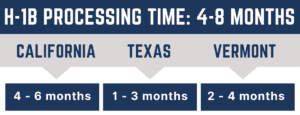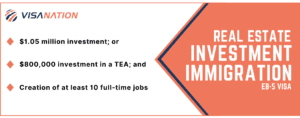2022 H1B Processing Time | How long to approve your application?
H-1B processing time is one of the most crucial parts of employment immigration to the U.S. However, each year, more and more people are vying to obtain the most popular U.S. work visa, the H-1B visa. Needless to say, most people who are interested in this visa want to know everything that is involved with the process. Read on to find out how long you have to wait from the moment your petition is filed to the day you can start working in the U.S.
Current H-1B Processing Time in 2022
Overall, the H-1B processing time is usually between 4 and 8 months, which is how long you will have to wait between filing and your work start date unless you are not being counted against the cap. Speak with your immigration attorney about cap-exempt petitions and how these cases differ from the usual processes.
Each step has its own processing time, which often varies depending on several outside factors. Things such as the LCA processing time, the cap window, the business of your USCIS service center, and Requests for Evidence can all contribute to variances in the H-1B processing time. The better you understand your case, the more accurately you can predict your processing time. This is why it is often best to hire an immigration attorney to help you along every step of the way.
Find out more about H-1B visa requirements.
Additionally, your employer can choose to file through premium processing, which will expedite the processing time for your petition. If not, then expect the H-1B processing time for the I-129 to be several months. This is dependent on several things such as how complete the petition is, how busy the USCIS service center is that received your petition, and the qualifications surrounding your qualifications and the qualifications of the position.
Learn about H-1B visa processing fees.
Processing Time By Service Centers
Although the overall wait time depends on the workload of the entire immigration system, H-1B processing time can also depend on which service center is reviewing your application. Some centers may have a larger workload than others, and for that reason may take longer to review your application. Keep in mind that the referenced wait times will change depending on the needs of the immigration system.
Below you will find H-1B wait times by service centers.
California Service Center – between 4 and 6 months
Texas Service Center – between 1 and 3 months
Vermont Service Center – between 2 and 4 months
H-1B Premium Processing
The USCIS extends a special feature called premium processing to all visa applicants who use either the I-129 or I-140 petition forms. For $2,500, you can shorten your petition’s H-1B processing time from several months to just 15 calendar days. However, this period only begins when the USCIS announces that it is starting to process petitions with premium processing. Be sure to check the USCIS website to learn when that begins.
For many work visas that require an I-129, premium processing is a welcome advantage. However, the cap-subject H-1B process has very specific and immutable dates that cannot be altered by this feature. Whether you use premium processing or not, your employer will still only be able to file your petition on April 1, 2023 and you will only be able to start working on or after October 1, 2023. So you will have to wait at least six months from filing to your employment start date, making premium processing significantly less effective.
However, if you are filing a petition to transfer your status to a new employer, filing for an H-1B extension, filing for a cap-exempt H-1B, or responding to an RFE, you are not bound by these dates and can file whenever you need to, which may be the perfect situation for premium processing.
See how H-1B visa benefits can help you decide if this visa is for you.
Also, keep in mind that premium processing does not increase your H-1B petition’s chances of being approved or selected in the lottery, it only speeds up the process and can only be used for the I-129 and I-140 petitions.
While premium processing might seem like a good idea to shorten the H-1B processing time, it is always a good idea to discuss decisions like this with your immigration attorney to see if your case can benefit from this feature.
H-1B Processing Time Delays: USCIS Requests for Evidence
Sometimes, the USCIS encounters a problem with petitions during the H-1B processing time. Rather than deny your petition outright, you may instead receive a Request for Evidence (RFE). As soon as your employer receives an RFE, there will be a time window in which a response must be given to avoid having your petition denied.
There are a variety of things that can trigger an RFE such as:
- An insufficient job description that does not portray the job as a specialty position requiring a bachelor’s degree or higher.
- A lack of evidence that you, the applicant, are qualified for the job either through a lack of experience or by having a degree that is not related to the position.
- A lack of proof that your sponsoring employer has complete control over your daily tasks, employment status, and wages.
Getting an RFE can cause a potentially harmful delay in your H-1B processing time. If you receive one, you may want to consider speaking to your immigration attorney about premium processing. It is important to note that premium processing does not prevent the USCIS from issuing an RFE.
Note that the above list is not comprehensive. The USCIS can issue an RFE for a large variety of reasons. See how the experienced attorneys at VisaNation Law group tackled a difficult H-1B Request for Evidence.
H-1B and LCA Processing Time
The LCA processing time for the form ETA 9035 usually takes about one week to process. However, if the Department of Labor finds any problems with your application, it may be rejected. Your employer will then be provided with a list of the issues that arose concerning your application. If your employer addresses these issues, the application can be resubmitted to the DOL.
Completing your LCA is generally best done before the H-1B season. This is because there is a very small window of opportunity to file the I-129 petition. It cannot be filed before April 1st, and the window closes after five business days if the cap is reached within that time.
Find out about H-1B to green card process.
Cap-Exempt Processing Time
There are obviously many benefits to filing a petition that is not subject to the H-1B cap, but a major advantage is the potential for a much shorter processing time. Not being subject to the cap means that your petition is also not subject to the time constraints placed on the cap. You do not need to wait until April 1st to file your petition and you do not need to wait until the first business day in October to start working. Essentially, a cap-exempt petition works like most other nonimmigrant visas in that your processing time is however long it takes for the petition to be processed. This can either be around six months (depending on the service center and any RFEs) or 15 calendar days with premium processing.
Cap-Exempt to Cap-Subject Processing Time
If you initially petitioned under a cap-exempt position (meaning that you were not counted against the cap), then you can transfer to another cap-exempt position normally. However, if you would like to transfer to a cap-subject position, your petition will need to be entered into the cap. This means that the transfer petition will need to be filed on April 1st and you will not be able to work for the new cap-subject employer until October 1st, which would add a significant amount of time to your H-1B processing time.





